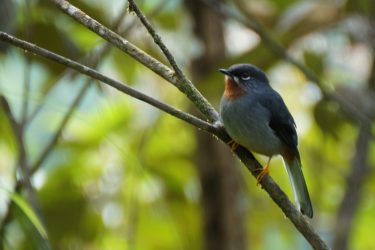In a series of blogs, Ed Drewitt freelance naturalist, broadcaster and wildlife detective takes us through the St Lucia Birding experience, which believe it or not starts with the ride from the airport to Anse Chastanet Resort
Lead Photo: Grey Kingbird, Credit: Ed Drewitt
By: Ed Drewitt
When travelling, the anticipation of what birds you might see when you arrive see is always exciting. Booking a window seat on the left-hand side of the aircraft you are likely to have stunning views of the lush green west coast of St Lucia, as the plane travels past Pigeon Island National Park, Castries and the Pitons, adjacent to Anse Chastanet.

Wildlife spotting begins even before you have left the airport! As the aircraft touches down Cattle Egrets might be slowly parading through the grassland on the edge of the airfield in search of insects and frogs.

As you head out of departures into the hot, steamy air, look out for medium-size purple-black (males) and sandy-brown (females) birds – these are Carib Grackles. They are usually in small loose groups on nearby grassland, overhead wires or lamp posts and through the villages of Laborie, Piaye, La Fargue and Choiseul, along the way to Anse Chastanet. As you head along the southern perimeter of the airport, look for Eared Doves on the ground or fences. And if you see any cattle, Cattle Egrets will be amongst their hooves, looking for insects.

The power lines are excellent places for bromeliads, plants that grow on the branches of trees, with a small root system for clinging on. They are part of the pineapple family and their succulent long upward pointing leaves overlap at the base, forming a bowl where they collect water. Ideal if you are stuck on a branch or electricity cable!
Keep your eyes peeled for two birds perched on the power lines – the Grey Kingbird and the American Kestrel. The Grey Kingbird is white bellied with a grey back and a thick, dark band across its eye. They love perching on the wires and flying out to catch a beetle or dragonfly, before returning to their perch. The kestrel meanwhile is a little larger and longer-bodied than the kingbird, with a short round head, longer tail and pointed wings. The kestrel perches on the wires and posts looking out for lizards, large insects and spiders.

As you pass through Soufriere watch out for street stalls of fresh, colorful vegetables and fruit. As you drive along the closer to the sea (along Bridge Street) Ospreys, Magnificent Frigatebirds and Laughing Gulls may be soaring over the bay while egrets and small herons feed by the river before it enters the sea near the cemetery. Next stop is Anse Chastanet!
In the next blog, Ed will describe the birdlife to look for when you arrive at Anse Chastanet.
Ed Drewitt is a freelance naturalist, broadcaster and wildlife detective
Learn More About Bird Watching at Anse Chastanet here

